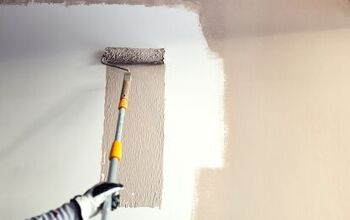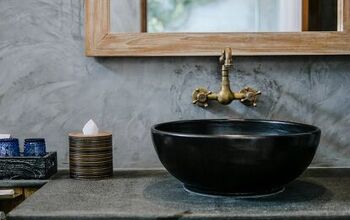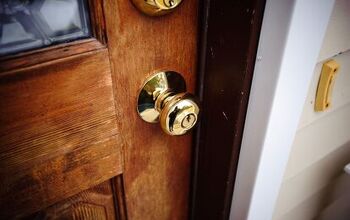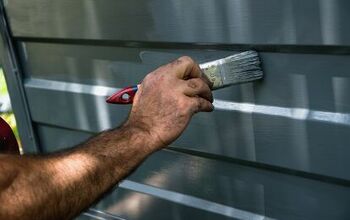Can You Paint Fiberglass Doors? (Find Out Now!)

Fiberglass exterior doors are becoming more popular with builders and homeowners upgrading their homes. Fiberglass doors offer a lot of advantages like those offered by steel or PVC door units. However, fiberglass door units offer only a few color options, and many homeowners wonder if they can paint a fiberglass door to match the exterior of their homes.
Painting fiberglass doors is much like painting wood or steel exterior doors. The biggest part is the preparation of the surface of the door before applying the finish. Using the right kind of primer and paints and the proper tools will contribute to a successful painting project for your fiberglass exterior door unit.
Fiberglass door units offer many advantages that can benefit a home. Greater curb appeal is one of those benefits that can be further increased by painting the door unit to match the rest of the home’s exterior. Painting a fiberglass exterior door is a project that most homeowners can accomplish with a little understanding and some step-by-step instructions.
Do You Need Exterior Home Paint or Stain Services?
Get free, zero-commitment quotes from pro contractors near you.

Fiberglass Doors – The Good and the Bad
Many people go through fiberglass exterior doors every day without realizing that the door is not wood. Fiberglass door units often mimic the look, feel, and operation of much more expensive wooden door units. Fiberglass doors offer more benefits than wood door units can’t provide.
- Fiberglass door units don’t warp, shrink, or swell like wooden doors. Fiberglass is stable despite exposure to cold, heat, or moisture.
- New fiberglass door units feature molded textures that so accurately simulate wood that when a good finish is applied, it is indistinguishable from real wood.
- Advanced insulation techniques often make fiberglass door units more energy efficient than wooden or steel doors.
- The same sorts of accessories and upgrades, such as window lights, panels, and high-security features, are available on fiberglass door units available on wood or steel doors.
On the downside, fiberglass door units aren’t applicable for everyone. Some situations don’t lend themselves well to a fiberglass door installation. Some of these situations include:
- Custom-sized door openings. Most fiberglass door units come in standard sizes. If the opening isn’t standard, trimming a fiberglass door unit is much more difficult than a wooden door.
- Fiberglass doors are not the cheapest nor the most expensive style of exterior door units. The average cost of fiberglass door units falls in the midrange of door units.
- Almost every fiberglass door unit comes pre-assembled and requires a knowledgeable professional to install a fiberglass door unit in an existing opening properly.
Painting A Fiberglass Door Unit
Once your new fiberglass door unit installation is complete, the next step is to prepare and paint the door unit to match the rest of your home. Fortunately, fiberglass doors require much less preparation work than wood door units. Easier surface preparation often makes the process of painting fiberglass doors a much easier project for many homeowners.
Following some basic rules for preparation and application can make the process go much easier and with fewer problems. To ensure the best possible outcomes, performing the processes in the right order is necessary. These step-by-step instructions can ensure any homeowner ends with a beautiful and functional finish on their door.
Step 1: Choose the Right Paint and Primer
Not all types of paint are suitable for fiberglass. To ensure proper adhesion and a long paint life, you should make sure the paint you chose is appropriate for applying to fiberglass. This warning goes for the primer you used as well. Typically, the best types of paint for fiberglass doors are:
- In general, you want to match the type of paint to the base fiberglass resin used to construct the door. These choices usually include:
Acrylic resinPolyester based resinEpoxy-based resin
- If you choose acrylic-based exterior house paint, the paint should be 100 percent acrylic. Acrylic blends may not adhere well to the fiberglass or weaken the fiberglass skin structure on the door unit.
- Most polyurethane-based paints are safe to use on fiberglass door units. Polyurethane generally doesn’t interact with the fiberglass structure and will adhere well to a properly prepared fiberglass surface.
- Applying epoxy-based paint should usually only be done on a fiberglass door with an epoxy-based fiberglass resin base.
- Your primer should match the type of paint you choose to use on your door. The manufacturer of your paint usually has a matching primer that ensures compatibility.
In general, oil-based or melamine paints are not appropriate for painting fiberglass door units. These products can penetrate the structure of the fiberglass and cause the structure to weaken or fail.
Step 2: Gather Your Tools and Equipment
Gathering all your tools and materials before you start your paint job is a good idea. Having everything in place before you start helps prevent frustration and delays as the project moves forward. We suggest that you have, at a minimum, the following.
Primer and paint
- A soft bristle brush to clear away dust and debris on the door surface
- Synthetic paintbrushes in various sizes
- Dry clothes and sponges for dusting and cleaning
- Painters tape to mask off edges, particularly on trim and glass. We suggest blue paper painter’s tape.
- Paint trays or small containers to make handling paint around the door easier and more convenient
- Newspaper or painter’s paper on rolls
- Work stands or sawhorses to hold the door flat while painting.
You may also need tools such as a screwdriver to remove hinges and door hardware. If the door unit is new, hardware may not be in place. However, if this is an existing door, you may need to remove the hardware.
Step 3: Remove the Door and Lay it Flat on Work Stands
It is much easier to apply the paint to the door and get a smooth flat finish if it lays flat on work stands or sawhorses. Place padding on the tops of the sawhorses to protect the door.
Step 4: Remove the Door Hardware and Weather-stripping from the Door
Remove all the door hardware from the door, including hinges, doorknob and fittings, and any weather stripping on the edges of the door. Put the hardware aside for re-installation later when the door is ready to rehang.
Step 5: Clean the Door Surfaces
Before applying primer or paint, the surfaces of the fiberglass door must be clean and dust-free. We suggest washing the surfaces of the door using a solution of a few drops of dishwashing detergent and clean water. Use a soft cloth dampened in the soap and water solution to wipe the surfaces of the door. Accumulations of stains may need special attention with a scrubbing sponge.
When the door is clean, rinse the door surfaces using clear water and a soft sponge dampened in the water and rinsed often. Allow the door to dry thoroughly before going any further with the painting project.
Clean both sides of the door before you start to prime or paint the surfaces.
Step 6: Mask any Windows or Trim on the Door
Use masking or painter’s tape and paper to carefully mask the edges to prevent stray paint from getting on these areas. Masking these edges will make clean up after the painting project much easier and faster.
Step 7: Prime the Door
When the door is properly prepared, clean, and masked, it is time to apply the primer. Follow the manufacturer’s recommendations when applying the primer. The primer directions can give you the necessary surface preparation, drying time, and clean-up information.
If your fiberglass door has a wood grain finish molded into the skin, apply the primer in the same direction as the wood grain. Avoid applying too much primer but make sure the coating is uniform and smooth. A good primer application provides a clean surface ready for the paint application ensuring a smooth, professional finish.
Step 8: Painting your Fiberglass Door
When the primer is dry, you are ready to apply paint to the door. Before you start, please read the directions on the paint can and follow them for the best results. Using a synthetic brush will help avid brush marks in the paint and give a smooth finish.
Follow any wood grain patterns on the surface of the door for best results. Please don’t neglect the edges of the door. Try and keep the thickness of the paint to a minimum so the door will close properly when it is re-installed.
Generally, two coats of paint will give a high-quality finish to your door. Wait until the first coat is fully dry before applying the second coat.
Step 9: Flip the Door and Paint the Other Side
Give the door plenty of time to dry and for the paint to harden. Flip the door and follow the same steps to paint the other side of the door. You should take extra care when painting the second side to prevent drips or runs on the areas you have already painted.
Step 10: Install the Hardware and Rehang the Door
Give your freshly painted door plenty of time for the paint to dry and cure. When everything is ready, reinstall the door hardware such as the doorknob, deadbolt, and hinges. Reposition the door in the door frame and screw the hinges into the door frame.
Check the door for proper swing and fit in the door frame. Adjust the locksets for proper clearance and operation. Remove any masking tape and paper. All that is left to do is to enjoy your newly painted fiberglass door unit.
Do You Need Exterior Home Paint or Stain Services?
Get free, zero-commitment quotes from pro contractors near you.

Giving your Fiberglass Door a New Look
Painting a fiberglass door unit is a project that almost any homeowner can accomplish. A fresh coat of paint can make even an older door look fresh and vibrant. A new look on the front door can make add curb appeal to your home. A fresh coat of paint is an easy way to give your home a fresh new look and feel.

Dennis is a retired firefighter with an extensive background in construction, home improvement, and remodeling. He worked in the trades part-time while serving as an active firefighter. On his retirement, he started a remodeling and home repair business, which he ran for several years.
More by Dennis Howard



























